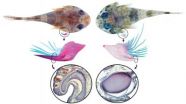(Press-News.org) COLLEGE STATION – Sometimes we think we know everything about something only to find out we really don't, said a Texas A&M University scientist.
Dr. Kevin Conway, assistant professor and curator of fishes with Texas A&M's department of wildlife and fisheries sciences at College Station, has published a paper documenting a new species of clingfish and a startling new discovery in a second well-documented clingfish.
Smithsonian Institution
The paper, entitled "Cryptic Diversity and Venom Glands in Western Atlantic Clingfishes of the Genus Acyrtus (Teleostei: Gobiesocidae)," was published May 13 in the PLOS ONE online journal. PLOS ONE is the Public Library of Science's peer reviewed, open-access scientific journal. The full study can be viewed at http://dx.plos.org/10.1371/journal.pone.0097664.
The scientific paper documents the study Conway and his team, including Dr. Carole Baldwin, his collaborator at the Smithsonian Institution, and Macaulay White, former Texas A&M undergraduate, have been working on for several years.
"We are excited about the study, because it resulted in not only the discovery of an undescribed species, but also the discovery of a unique venom gland in a group of fishes nobody knew were venomous," Conway said. "New groups of venomous fishes are not discovered very often, in fact the last such discovery happened back in the 1960s. The shocking thing is that the fishes that possess the venom gland have been known to science for a long time, some for over 260 years, and have been pretty well studied."
Conway said he has not been involved in a discovery of this magnitude since he joined the Texas A&M faculty.
Conway said clingfishes are globally distributed at temperate and tropical latitudes, and get their name from their ability to anchor themselves using their large belly sucker. The species Conway and his team discovered is a tiny marine fish less than an inch long that lives between pieces of coral rubble in very shallow water along the coast of Belize and islands in the Caribbean and Bahamas.
"Our work shows that even in relatively well-studied areas of the world's oceans, new species can be discovered as can unknown traits in well-documented species." Conway said.
Conway explained that in order to describe a new species, taxonomists have to make comparisons with other closely related species to ensure they are not "rediscovering" something already described by another researcher.
"During that comparison process we discovered that several species of Caribbean clingfishes, but not the new one we found, have a strange gland associated with a very sharp and spine-like subopercular bone, one of four bones that support the gill covers in fishes," Conway said. "The cells inside the gland are incredibly similar to those present inside the venom glands of scorpion fishes and certain catfish and based on this similarity, we are confident that these clingfishes are also producing some type of toxin."
"Discovering a venom gland in a group of well-studied fishes that has been known to science, some for well over two centuries, is truly remarkable," Conway said.
Conway explained that most of the world's 2,000-plus venomous species of fishes deliver their venom using a modified fin ray, sharp opercular spine or even through a large fang in their lower jaw. But the venom gland they discovered in the Caribbean clingfishes associated with the subopercular gill cover bone is the first of its kind to be discovered and in fact, is unique among all venomous fish described to-date.
"We do not know exactly what the venom is used for, but based on the position of the venom gland, it is more likely that it would be used for protection, as in most venomous fishes.
"We don't yet have any information about the toxic properties of these clingfishes, but we hope that our discovery will encourage other scientists to take a look at the venom gland we discovered in more detail," he said.
Conway said clingfishes are referred to as crypto-benthic fishes which means "small, bottom dwellers."
"Crypto-benthic fishes are not commercially important, but are considered by the scientific community to play an important role in marine ecosystems, because they are likely an important food resource for larger fishes," Conway noted.
INFORMATION: END
Tiny, tenacious and tentatively toxic
Texas A&M scientist makes 2 discoveries that were hiding in plain sight
2014-05-14
ELSE PRESS RELEASES FROM THIS DATE:
Chapman University affiliated physicist publishes on the Aharonov-Bohm effect in Nature
2014-05-14
ORANGE, Calif. – Chapman University affiliated quantum physicist Yutaka Shikano, Ph.D., has published a milestone paper in the prestigious journal Nature Communications. The title of the article is "Aharonov-Bohm effect with quantum tunneling in linear Paul trap." The Aharonov-Bohm (AB) effect was proposed by Yakir Aharonov, who is the co-director of the Institute for Quantum Studies at Chapman University, and David J. Bohm in 1959.
The AB effect showed for the first time that a magnetic field inside a confined region can have a measureable impact on a charged particle ...
Simplifying an ultrafast laser offers better control
2014-05-14
This news release is available in French. Going back to the drawing board to find a way to overcome the technical limitations of their laser, a team led by François Légaré, professor at the INRS Énergie Matériaux Télécommunications Research Centre, developed a new concept offering a simpler laser design, control over new parameters, and excellent performance potential. Called "frequency domain optical parametric amplification" (FOPA), the concept supersedes traditional time domain amplification schemes that have been the linchpin of ultrafast laser science for 20 years. ...
Magnetar formation mystery solved?
2014-05-14
When a massive star collapses under its own gravity during a supernova explosion it forms either a neutron star or black hole. Magnetars are an unusual and very exotic form of neutron star. Like all of these strange objects they are tiny and extraordinarily dense — a teaspoon of neutron star material would have a mass of about a billion tonnes — but they also have extremely powerful magnetic fields. Magnetar surfaces release vast quantities of gamma rays when they undergo a sudden adjustment known as a starquake as a result of the huge stresses in their crusts.
The Westerlund ...
Microchip-like technology allows single-cell analysis
2014-05-14
VIDEO:
This is a microscopic view of the new microchip-like technology sorting and storing magnetic particles in a three-by-three array.
Click here for more information.
DURHAM, N.C. -- A U.S. and Korean research team has developed a chip-like device that could be scaled up to sort and store hundreds of thousands of individual living cells in a matter of minutes. The system is similar to a random access memory chip, but it moves cells rather than electrons.
Researchers at ...
Using nature as a model for low-friction bearings
2014-05-14
Lubricants are required wherever moving parts come together. They prevent direct contact between solid elements and ensure that gears, bearings, and valves work as smoothly as possible. Depending on the application, the ideal lubricant must meet conflicting requirements. On the one hand, it should be as thin as possible because this reduces friction. On the other hand, it should be viscous enough that the lubricant stays in the contact gap. In practice, grease and oils are often used because their viscosity increases with pressure.
Biological lubrication in contrast is ...
Early menopause ups heart failure risk, especially for smokers
2014-05-14
CLEVELAND, Ohio (May 14, 2014)—Women who go through menopause early—at ages 40 to 45—have a higher rate of heart failure, according to a new study published online today in Menopause, the journal of The North American Menopause Society (NAMS). Smoking, current or past, raises the rate even more.
Research already pointed to a relationship between early menopause and heart disease—usually atherosclerotic heart disease. But this study from the Karolinska Institute in Stockholm, Sweden, is the first to demonstrate a link with heart failure, the inability of the heart to pump ...
Virginia Tech updates football helmet ratings, 5 new helmets meet 5-star mark
2014-05-14
Virginia Tech has updated results of its adult football helmet ratings, which are designed to identify key differences between the abilities of individual helmets to reduce the risk of concussion.
All five of the new adult football helmets introduced this spring earned the five-star mark, which is the highest rating awarded by the Virginia Tech Helmet Ratings™. The complete ratings of the helmets manufactured by Schutt Sports and Xentih LLC, each with two new products, and Rawlings Sporting Goods Co., with one helmet, are publicly available at the helmet ratings website.
The ...
Primates and patience -- the evolutionary roots of self control
2014-05-14
Lincoln, Neb., May 14, 2014 – A chimpanzee will wait more than two minutes to eat six grapes, but a black lemur would rather eat two grapes now than wait any longer than 15 seconds for a bigger serving.
It's an echo of the dilemma human beings face with a long line at a posh restaurant. How long are they willing to wait for the five-star meal? Or do they head to a greasy spoon to eat sooner?
A paper published today in the scientific journal Proceedings of the Royal Society B explores the evolutionary reasons why some primate species wait for a ...
Human learning altered by electrical stimulation of dopamine neurons
2014-05-14
PHILADELPHIA - Stimulation of a certain population of neurons within the brain can alter the learning process, according to a team of neuroscientists and neurosurgeons at the University of Pennsylvania. A report in the Journal of Neuroscience describes for the first time that human learning can be modified by stimulation of dopamine-containing neurons in a deep brain structure known as the substantia nigra. Researchers suggest that the stimulation may have altered learning by biasing individuals to repeat physical actions that resulted in reward.
"Stimulating the substantia ...
Hospital rankings for heart failure readmissions unaffected by patient's socioeconomic status
2014-05-13
A new report by Icahn School of Medicine at Mount Sinai, published in the journal Circulation: Cardiovascular Quality and Outcomes, shows the socioeconomic status of congestive heart failure patients does not influence hospital rankings for heart failure readmissions.
In the study, researchers assessed whether adding a standard measure for indicating the socioeconomic status of heart failure patients could alter the expected 30-day heart failure hospital risk standardized readmission rate (RSRR) among New York City hospitals. For each patient a standard socioeconomic ...
LAST 30 PRESS RELEASES:
Tracing the quick synthesis of an industrially important catalyst
New software sheds light on cancer’s hidden genetic networks
UT Health San Antonio awarded $3 million in CPRIT grants to bolster cancer research and prevention efforts in South Texas
Third symposium spotlights global challenge of new contaminants in China’s fight against pollution
From straw to soil harmony: International team reveals how biochar supercharges carbon-smart farming
Myeloma: How AI is redrawing the map of cancer care
Manhattan E. Charurat, Ph.D., MHS invested as the Homer and Martha Gudelsky Distinguished Professor in Medicine at the University of Maryland School of Medicine
Insilico Medicine’s Pharma.AI Q4 Winter Launch Recap: Revolutionizing drug discovery with cutting-edge AI innovations, accelerating the path to pharmaceutical superintelligence
Nanoplastics have diet-dependent impacts on digestive system health
Brain neuron death occurs throughout life and increases with age, a natural human protein drug may halt neuron death in Alzheimer’s disease
SPIE and CLP announce the recipients of the 2025 Advanced Photonics Young Innovator Award
Lessons from the Caldor Fire’s Christmas Valley ‘Miracle’
Ant societies rose by trading individual protection for collective power
Research reveals how ancient viral DNA shapes early embryonic development
A molecular gatekeeper that controls protein synthesis
New ‘cloaking device’ concept to shield sensitive tech from magnetic fields
Researchers show impact of mountain building and climate change on alpine biodiversity
Study models the transition from Neanderthals to modern humans in Europe
University of Phoenix College of Doctoral Studies releases white paper on AI-driven skilling to reduce burnout and restore worker autonomy
AIs fail at the game of visual “telephone”
The levers for a sustainable food system
Potential changes in US homelessness by ending federal support for housing first programs
Vulnerability of large language models to prompt injection when providing medical advice
Researchers develop new system for high-energy-density, long-life, multi-electron transfer bromine-based flow batteries
Ending federal support for housing first programs could increase U.S. homelessness by 5% in one year, new JAMA study finds
New research uncovers molecular ‘safety switch’ shielding cancers from immune attack
Bacteria resisting viral infection can still sink carbon to ocean floor
Younger biological age may increase depression risk in older women during COVID-19
Bharat Innovates 2026 National Basecamp Showcases India’s Most Promising Deep-Tech Ventures
Here’s what determines whether your income level rises or falls
[Press-News.org] Tiny, tenacious and tentatively toxicTexas A&M scientist makes 2 discoveries that were hiding in plain sight







